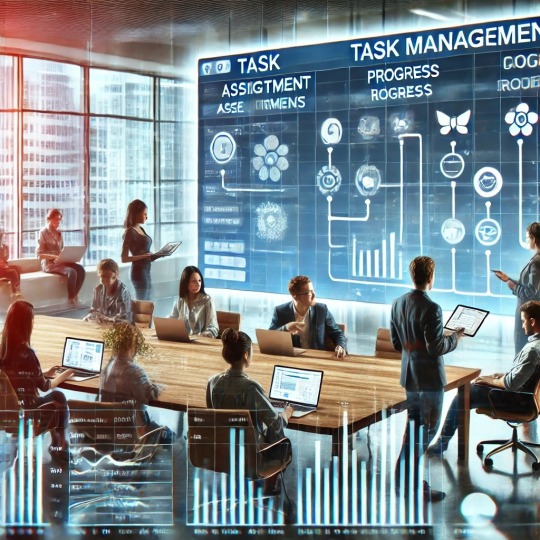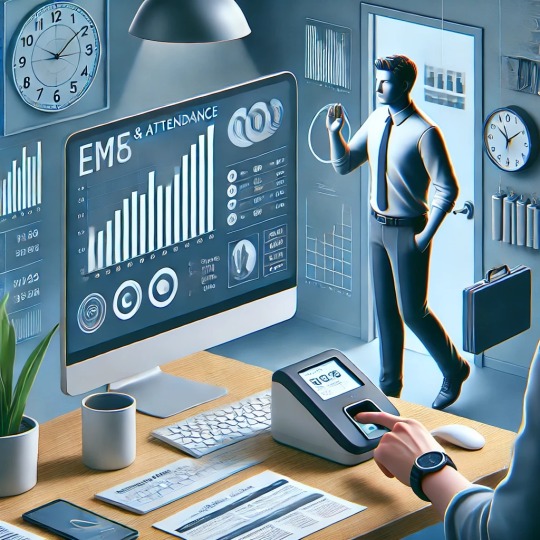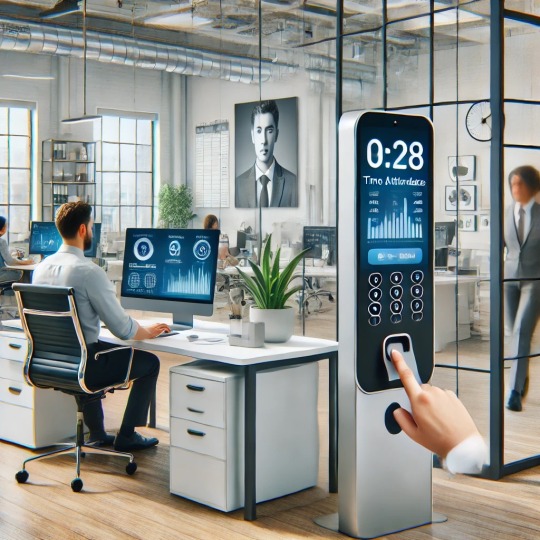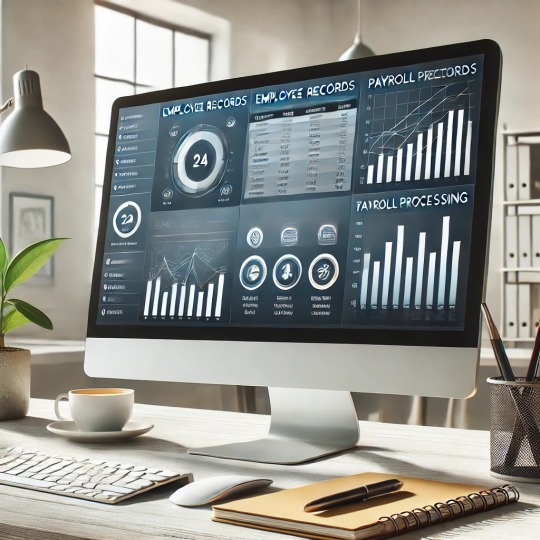Don't wanna be here? Send us removal request.
Text
Optimized Task Management for Enhanced Team Collaboration and Productivity
Task management systems streamline project workflows by enabling teams to assign, prioritize, and track tasks effectively. These platforms offer features like progress tracking, deadline reminders, and collaborative tools that ensure timely completion of projects. With clear visualizations of goals and responsibilities, task management solutions promote accountability and enhance team communication. Businesses can boost productivity, minimize delays, and achieve operational excellence by centralizing task organization.
More info: https://ahalts.com/products/hr-management

#Task Management#Project Collaboration#Task Tracking Software#Productivity Tools#Team Management#Workflow Optimization#Task Prioritization#Deadline Tracking#Project Organization
0 notes
Text
Streamlined Time and Attendance Management for Enhanced Workforce Efficiency
Effective time and attendance management is crucial for maintaining workforce productivity and compliance. Advanced systems leverage technology like biometric devices, mobile apps, and cloud-based platforms to track employee work hours accurately. These tools provide real-time data on attendance, overtime, and leave, ensuring seamless payroll integration and better workforce planning. Businesses can minimize errors, enhance efficiency, and focus on strategic growth by automating attendance processes.
More info: https://ahalts.com/solutions/hr-services/outsourcing-time-attendance

#Time and Attendance Management#Biometric Attendance#Employee Time Tracking#Attendance Software#Workforce Productivity#Leave Management#Work Hours Monitoring#Automated Attendance System#Real-Time Tracking#HR Solutions
0 notes
Text
Efficient Payroll Management Solutions for Accurate and Timely Employee Compensation
Efficient payroll management is essential for maintaining employee trust and ensuring compliance with financial regulations. Payroll software simplifies the process by automating salary calculations, tax deductions, and payment scheduling. This technology reduces errors, saves time, and provides detailed reports for compliance and transparency. A modern payroll solution integrates seamlessly with other HR functions, offering scalability and customization to meet the unique needs of businesses. Streamline your payroll process to enhance accuracy, reduce administrative burden, and ensure timely employee payments.
More info: https://ahalts.com/solutions/hr-services/complete-payroll

#Payroll Management#Payroll Software#Salary Processing#Tax Deductions#Employee Compensation#Wage Calculation#Automated Payroll#Compliance Reporting#Payment Schedules#HR Payroll Solutions
0 notes
Text
Comprehensive HRMS Solutions for Streamlined Workforce Management
A Human Resource Management System (HRMS) is a comprehensive software solution designed to optimize and automate core HR functions. From payroll and attendance tracking to recruitment and employee performance management, an HRMS streamlines operations, saving time and improving accuracy. Advanced features like workforce analytics, compliance tools, and mobile accessibility ensure businesses can scale efficiently while fostering employee engagement. Tailor your HRMS to fit your organization’s needs and unlock the potential for a productive and satisfied workforce.
More info: https://ahalts.com/solutions/hr-services

#HRMS#HR Software#Workforce Management#Payroll Management#Recruitment Software#Employee Self-Service#Performance Analytics#Attendance Tracking#HR Technology#Talent Management
0 notes
Text
How to Create a Task Management System That Works for You
In today’s fast-paced world, juggling multiple responsibilities can feel overwhelming. A reliable task management system can help you stay organized, prioritize effectively, and reduce stress. But what works for one person might not work for another. Here’s a step-by-step guide to creating a task management system tailored to your needs.
1. Assess Your Current Workflow
Before setting up a task management system, take a closer look at how you currently manage tasks. Ask yourself:
How do you track tasks now (e.g., lists, apps, calendars)?
What challenges are you facing (e.g., forgetting deadlines, feeling overwhelmed)?
Are you prioritizing tasks effectively?
Understanding your strengths and pain points will guide you in building a system that addresses your specific needs.
2. Choose the Right Tools
The right tool can make or break your task management system. Here are some popular options:
Digital Tools: Apps like Trello, Asana, or Microsoft To-Do offer flexibility and collaboration features.
Paper-Based Tools: Planners, notebooks, or bullet journals work well for those who prefer handwritten systems.
Hybrid Approach: Combine digital tools with paper for a balance of structure and creativity.
Choose tools that match your working style and are easy to integrate into your daily routine.
3. Organize Tasks into Categories
Divide your tasks into manageable categories to avoid feeling overwhelmed. Common categories include:
Work: Job-related projects and deadlines.
Personal: Family responsibilities, health, and hobbies.
Recurring: Tasks like bills, meetings, or maintenance.
Creating categories helps you maintain focus and allocate your time efficiently.
4. Prioritize Effectively
Not all tasks are equally important. Use a prioritization method to decide what needs your attention first:
Eisenhower Matrix: Categorize tasks as urgent/important, not urgent/important, urgent/not important, or not urgent/not important.
ABC Method: Label tasks as A (high priority), B (medium priority), or C (low priority).
Deadlines: Rank tasks based on when they are due.
5. Break Down Larger Tasks
Big projects can be daunting. Break them into smaller, actionable steps. For example, instead of “Launch website,” break it down into steps like:
Create a site map.
Write website copy.
Choose a web hosting service.
This approach makes tasks more manageable and ensures steady progress.
6. Set Realistic Deadlines
Deadlines are essential for staying on track, but unrealistic ones can cause unnecessary stress. Assign achievable timeframes for each task and adjust them as needed.
7. Establish a Routine
Consistency is key to making your task management system effective. Set aside dedicated time daily or weekly to:
Review upcoming tasks.
Update progress on current tasks.
Adjust priorities based on new developments.
8. Use Reminders and Alerts
Leverage reminders to ensure you don’t forget important deadlines. Calendar apps, task management tools, or even simple alarms can help you stay on top of your to-do list.
9. Regularly Evaluate and Adjust
Your task management system isn’t set in stone. Periodically review its effectiveness and make changes as your needs evolve. For example:
If you’re consistently missing deadlines, reassess your scheduling strategy.
If a tool isn’t working for you, explore other options.
10. Stay Flexible
Life is unpredictable, and not everything will go according to plan. Build flexibility into your system to accommodate last-minute changes or unexpected delays without derailing your progress.
Conclusion
Creating a task management system that works for you takes time and experimentation. By understanding your workflow, using the right tools, and staying adaptable, you can build a system that helps you stay organized and productive. Start small, refine your approach, and watch your efficiency soar.
More info: https://ahalts.com/products/hr-management

#Task Management#Productivity Tools#Collaboration#Workflow Optimization#Organized Workspace#Digital Tools#Efficiency#Teamwork
0 notes
Text
How Time and Attendance Systems Boost Employee Productivity
In today’s fast-paced business environment, managing time effectively is critical for both employees and employers. Time and attendance systems have evolved from simple punch cards to sophisticated digital solutions, offering a range of benefits that go beyond tracking work hours. Here’s how these systems play a crucial role in enhancing employee productivity.
1. Eliminating Manual Errors
Traditional timekeeping methods, such as manual logs or spreadsheets, are prone to human errors. Mistakes in recording work hours can lead to disputes, payroll inaccuracies, and wasted time resolving issues. Modern time and attendance systems automate these processes, ensuring accuracy and reducing administrative burdens, allowing employees to focus on their core tasks.
2. Streamlining Administrative Tasks
Automated time and attendance systems significantly reduce the time HR and managers spend on administrative duties. Tasks like tracking overtime, managing leave requests, and calculating payroll are streamlined, freeing up time for strategic initiatives and employee engagement efforts.
3. Enhancing Accountability
With precise time tracking, employees become more accountable for their schedules. Knowing that their attendance and work hours are being accurately monitored fosters discipline and reduces instances of tardiness or early departures.
4. Supporting Flexible Work Arrangements
Time and attendance systems often include features like remote clock-ins and mobile apps. This flexibility allows businesses to support remote work, hybrid models, and shift work efficiently. Employees can log their hours from anywhere, ensuring that productivity isn’t compromised by location.
5. Providing Real-Time Insights
Advanced systems offer analytics and reporting features, enabling managers to monitor workforce trends, identify bottlenecks, and optimize schedules. For example, tracking peak productivity hours or detecting patterns of absenteeism can help businesses make informed decisions to improve workflow.
6. Improving Employee Morale
When employees see that their hours are accurately tracked and reflected in timely, error-free payroll, it builds trust and satisfaction. Features like self-service portals also empower employees to check their attendance records, apply for leave, or view their schedules, fostering transparency and reducing confusion.
7. Encouraging Better Time Management
Time and attendance systems often include reminders and notifications for clock-ins, breaks, and deadlines. These prompts encourage employees to manage their time effectively and stay on task, contributing to higher productivity levels.
8. Ensuring Compliance
For businesses, staying compliant with labor laws and overtime regulations is essential. Time and attendance systems automatically calculate work hours and flag potential compliance issues, reducing the risk of legal complications. This allows employees to work confidently within the framework of labor laws.
9. Reducing Time Theft
Features like biometric clock-ins or geolocation tracking prevent practices such as buddy punching or unauthorized overtime. By minimizing time theft, businesses can save costs and allocate resources more effectively.
10. Optimizing Workforce Planning
With accurate data on employee availability and work hours, managers can create efficient schedules that balance workload distribution and avoid overburdening team members. This not only boosts productivity but also prevents burnout.
Conclusion
Time and attendance systems are more than just tools for tracking hours—they’re a powerful resource for enhancing productivity, improving workforce management, and building a transparent workplace culture. By adopting modern systems, businesses can save time, reduce errors, and empower employees to perform at their best.
More info: https://ahalts.com/solutions/hr-services/outsourcing-time-attendance

#Time and attendance systems#Employee productivity#Workforce management#Attendance tracking#Time tracking software#Employee accountability#Digital timekeeping#Workplace efficiency#Remote work tracking#Biometric attendance systems#HR technology
0 notes
Text
How to Choose the Best Payroll Software for Your Business
Managing payroll effectively is critical for any business. It ensures employees are paid on time, complies with legal requirements, and builds trust within the organization. With numerous payroll software options available, choosing the right one can seem overwhelming. Here's a guide to help you select the best payroll software for your business needs.
1. Understand Your Business Needs
Start by identifying the specific payroll challenges your business faces. Consider factors like:
The size of your workforce.
Frequency of payroll processing (weekly, bi-weekly, monthly).
Employee types (full-time, part-time, contractors).
Need for tax filing and compliance support.
2. Key Features to Look For
A good payroll software solution should have essential features to streamline your payroll process. Look for:
Automation: Automatic salary calculations, tax deductions, and compliance updates.
Direct Deposit: Ability to pay employees directly to their bank accounts.
Tax Management: Automatic generation and filing of tax forms like W-2s and 1099s.
Employee Self-Service: Portals for employees to view payslips, update personal details, and manage tax information.
Scalability: Software that grows with your business as you add employees.
Integration: Compatibility with your existing HR, accounting, and time-tracking tools.
3. Consider Ease of Use
Payroll software should simplify your tasks, not complicate them. Opt for a solution with an intuitive interface, clear navigation, and user-friendly dashboards. Many providers offer free trials—take advantage of these to assess usability.
4. Prioritize Security
Payroll data contains sensitive employee information. Choose software with robust security features, such as:
Data encryption.
Multi-factor authentication.
Regular updates to protect against cyber threats.
5. Evaluate Support and Customer Service
When issues arise, having reliable customer support is invaluable. Look for software providers that offer:
24/7 support.
Multiple channels for help (chat, phone, email).
Comprehensive documentation or training resources.
6. Compare Pricing Options
Payroll software pricing varies widely based on features and scale. Understand the cost structure:
Subscription fees (monthly or annual).
Per-employee charges.
Additional costs for features like tax filing or advanced analytics. Choose software that fits your budget without compromising on essential features.
7. Read Reviews and Seek Recommendations
Explore reviews on trusted platforms like G2, Capterra, or Trustpilot. Ask for recommendations from peers or industry networks to gain insights into the software’s performance and reliability.
8. Opt for Cloud-Based Solutions
Cloud-based payroll software offers flexibility and convenience. It allows you to access payroll data anytime, anywhere, and often includes automatic updates for compliance and feature improvements.
9. Assess Scalability and Future-Proofing
If your business is growing, ensure the payroll software can handle increased demands. Look for solutions that allow you to add new employees or expand to global payroll systems seamlessly.
10. Test Before You Buy
Most payroll software providers offer free trials or demos. Use these to evaluate the software’s functionality, ease of use, and how well it integrates into your existing processes.
Conclusion
Choosing the best payroll software for your business involves understanding your specific needs, prioritizing essential features, and evaluating options carefully. By investing in the right solution, you can streamline payroll processes, ensure compliance, and focus more on growing your business.
More info: https://ahalts.com/solutions/hr-services/complete-payroll

#Payroll software#Business payroll solutions#Payroll management#Payroll tools#Employee salary processing#Payroll automation#Small business software#Payroll software features#Payroll compliance#Tax management software
0 notes
Text
The Evolution of HR Technology: A Look at Modern HRMS
The landscape of human resource management has undergone a significant transformation over the years. From manual processes and paper records to sophisticated Human Resource Management Systems (HRMS), technology has revolutionized the way HR functions. Here's a look at how HR technology has evolved and why modern HRMS solutions are game-changers for businesses.
The Early Days of HR Technology
Initially, HR tasks were heavily dependent on manual processes. Payroll calculations, employee records, and recruitment were managed through spreadsheets and paper files. While this approach worked, it was time-consuming, prone to errors, and inefficient for scaling businesses.
The Rise of HR Software Solutions
In the 1990s, the introduction of basic HR software paved the way for automation in payroll, attendance tracking, and record-keeping. These systems significantly reduced administrative workload but were often standalone solutions, lacking integration and advanced functionality.
Modern HRMS: An All-in-One Solution
Today, HRMS represents a holistic approach to human resource management, combining multiple functionalities into a unified platform. These systems are designed to streamline and automate complex HR tasks, improve efficiency, and enhance the employee experience.
Key Features of Modern HRMS
Employee Data Management: Centralized storage of employee information for easy access and updates.
Payroll and Benefits Administration: Automation of salary processing, tax calculations, and benefits management.
Recruitment and Onboarding: Tools for posting job ads, tracking candidates, and onboarding new hires seamlessly.
Performance Management: Advanced analytics for tracking employee performance and setting development goals.
Employee Self-Service Portals: Empowering employees to manage their own leave, attendance, and personal details.
Compliance Tracking: Ensuring adherence to labor laws and regulations with minimal manual effort.
Integration with Other Tools: Compatibility with third-party applications for enhanced functionality.
Benefits of Modern HRMS
Efficiency and Productivity: Automation reduces repetitive tasks, freeing up HR professionals for strategic planning.
Data-Driven Decision Making: Advanced analytics provide insights into workforce trends and performance metrics.
Improved Employee Engagement: Self-service features and streamlined processes enhance employee satisfaction.
Scalability: Modern HRMS platforms are designed to grow with the organization, making them ideal for businesses of all sizes.
Future Trends in HR Technology
As technology continues to evolve, HRMS is expected to integrate more advanced features, such as:
Artificial Intelligence (AI): Predictive analytics for hiring, retention, and employee development.
Mobile-First Solutions: Ensuring accessibility on the go.
Enhanced Employee Wellness Tools: Integrating mental health and wellness tracking into HR systems.
Conclusion
The evolution of HR technology from manual processes to modern HRMS has been a transformative journey. Today’s HRMS solutions empower organizations to manage their workforce efficiently while fostering a better workplace environment. Investing in the right HRMS is not just a technological upgrade—it’s a strategic move towards building a smarter and more agile organization.
More info: https://ahalts.com/solutions/hr-services

#HR technology#HRMS evolution#Modern HR systems#HR automation#Workforce management#Employee management tools#HR software trends#Human resource innovation#Payroll automation#HR analytics#HR compliance#Recruitment technology#Employee engagement#HRIS vs. HRMS
0 notes
Text
Payroll and Benefits Services
Payroll and Benefits Services provide comprehensive support for managing employee compensation and benefits programs, ensuring timely and accurate payroll processing while administering benefits like health insurance, retirement plans, and paid leave. These services are designed to streamline administrative tasks, reduce errors, and help companies stay compliant with regulatory standards. By outsourcing or utilizing specialized payroll and benefits services, businesses can focus on growth and core functions, while employees enjoy a reliable and accessible system for managing their compensation and benefits.

#payroll and benefits services#employee compensation management#payroll processing services#employee benefits solutions#HR and payroll services
0 notes
Text
Integrated Payroll and Benefits Solutions
Integrated Payroll and Benefits Solutions provide a seamless approach to managing employee compensation and benefits in one unified system. This service integrates payroll processing with benefits administration, enabling real-time updates, simplified data management, and consistent compliance with tax and labor regulations. By consolidating these essential functions, businesses can reduce administrative workload, improve data accuracy, and provide employees with a streamlined, accessible experience for tracking their payroll and benefits. Integrated solutions enhance operational efficiency, support better decision-making, and contribute to higher employee satisfaction and retention.

#integrated payroll solutions#payroll and benefits management#employee compensation and benefits#payroll integration services#unified payroll and benefits#benefits administration solutions
0 notes
Text
Employee Payroll & Benefits Management
Employee Payroll & Benefits Management focuses on ensuring that all employees are accurately compensated and have access to comprehensive benefits. This service includes the processing of payroll, managing benefits enrollment, handling tax deductions, and ensuring compliance with local, state, and federal regulations. By providing a streamlined approach to payroll and benefits, businesses can enhance employee satisfaction, reduce errors, and maintain efficient records. Effective payroll and benefits management supports both the financial wellness and engagement of employees, contributing to a positive workplace environment and aiding in employee retention.

#employee payroll management#payroll and benefits services#employee compensation management#benefits administration#employee benefits enrollment#payroll and benefits compliance
0 notes
Text
Comprehensive Payroll & Benefits Administration
Comprehensive Payroll & Benefits Administration is designed to streamline payroll processing and benefits management, ensuring accurate and timely employee compensation. This service covers all aspects of payroll, from calculating wages and withholding taxes to distributing payments, while also managing benefits like health insurance, retirement plans, and paid leave. By integrating payroll with benefits administration, companies can improve efficiency, maintain compliance with regulatory standards, and enhance employee satisfaction. Comprehensive payroll and benefits administration solutions allow businesses to focus on growth while ensuring employees are compensated and supported effectively
More info: https://ahalts.com/solutions/hr-services/complete-payroll

#payroll administration#employee benefits management#payroll processing#compensation solutions#benefits administration#payroll and benefits integration
0 notes
Text
Top HRMS Features to Boost Employee Engagement and Productivity
Top HRMS features are designed to enhance employee engagement and productivity by creating a seamless and supportive workplace experience. Self-service portals empower employees to manage personal information, access pay stubs, and track time off without HR intervention, saving time and increasing autonomy. Performance management tools within an HRMS allow for continuous feedback, goal-setting, and progress tracking, which keep employees motivated and aligned with company objectives. Additionally, automated learning and development modules provide easy access to training resources, supporting employee growth and skills enhancement. With engagement surveys and analytics, HRMS platforms enable companies to gather real-time insights into employee satisfaction, helping HR teams make informed improvements. Together, these features contribute to a workplace that is both efficient and employee-centered, fostering engagement and boosting productivity.
More info: https://ahalts.com/solutions/hr-services
#HRMS features for engagement#Employee productivity HRMS#Self-service HRMS benefits#HRMS for employee engagement#Performance management in HRMS#HRMS tools for productivity#Learning and development HRMS
0 notes
Text
Top Benefits of Automated Payroll Processing for Small Businesses
Automated payroll processing substantially benefits small businesses, streamlining operations and minimizing errors. By replacing manual processes with automated solutions, companies can save time, reduce compliance risks, and improve accuracy in employee payments. Automated payroll systems ensure that taxes are calculated correctly, deadlines are met, and deductions are accurately applied, preventing costly mistakes. Additionally, automation provides small business owners and HR teams valuable insights through payroll reports and analytics, enabling better financial planning and decision-making. With user-friendly features and integration capabilities, automated payroll processing is an essential tool that enhances efficiency, accuracy, and overall productivity for small businesses.
More info: https://ahalts.com/solutions/payroll-services/online-payroll

#Automated payroll benefits#Payroll processing for small business#Small business payroll automation#Benefits of payroll software#Payroll software for small businesses#Payroll automation advantages#Accurate payroll processing
0 notes
Text
How HRMS is Transforming the Modern Workplace
Human Resource Management Systems (HRMS) are revolutionizing the modern workplace by streamlining HR operations, enhancing employee engagement, and supporting data-driven decision-making. Through automation, HRMS simplifies complex processes like payroll, attendance tracking, and performance management, allowing HR teams to focus on strategic initiatives rather than administrative tasks. With features such as self-service portals, real-time analytics, and mobile accessibility, HRMS platforms empower employees to manage their own data and stay engaged with their work. Additionally, HRMS tools provide valuable insights that help organizations improve workforce planning and adapt to evolving workplace trends. By transforming HR processes, HRMS contributes to a more efficient, productive, and employee-centered work environment.
More info: https://ahalts.com/solutions/hr-services

#HRMS modern workplace#HRMS transformation#Benefits of HRMS in workplace#HR technology for modern offices#Employee engagement HRMS#HRMS automation benefits#Workplace productivity HRMS
0 notes
Text
A Guide to Choosing the Right Payroll Software for Your Business
Choosing the right payroll software is essential for businesses seeking efficiency, accuracy, and compliance in their payroll processing. With a wide range of solutions available, it’s crucial to find a platform that meets your company’s specific needs, from managing employee payments and tax calculations to handling benefits and deductions. Modern payroll software should integrate seamlessly with other HR systems, provide user-friendly reporting tools, and support compliance with local and federal regulations. This guide covers key factors to consider—such as scalability, ease of use, and security—helping businesses select a payroll solution that enhances productivity and simplifies payroll management.
More info: https://ahalts.com/products/hr-management/payroll

#Payroll software guide#Choosing payroll software#Best payroll software for business#Payroll management software#Payroll software features#payroll software comparison
0 notes
Text
How HRMS Transforms Employee Experience and Boosts Retention
Human Resource Management Systems (HRMS) have revolutionized how companies engage, manage, and retain their employees. HRMS enhances every step of the employee journey by streamlining processes like onboarding, performance management, and employee feedback. Employees benefit from faster, more efficient workflows and greater access to personalized support, which increases their engagement and satisfaction with their roles. Additionally, HRMS platforms enable real-time analytics, allowing companies to identify potential retention risks and address them proactively. Through this holistic approach, HRMS improves operational efficiency and strengthens employee loyalty and long-term retention.
More info: https://ahalts.com/solutions/hr-services/complete-payroll

#HRMS employee experience#HRMS and employee retention#HR technology for retention#Enhancing employee satisfaction with HRMS#Employee engagement software
0 notes